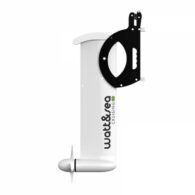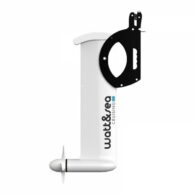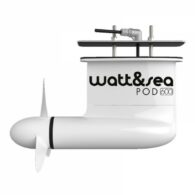Sommaire
I) Qu’est ce qu’un hydrogénérateur ?
II) Les performances
III) La gamme Watt&Sea
VI) Les Hydrogénérateur chez Comptoir Nautique
LE guide d'achat des hydrogÉnÉrateurs
Sur un bateau, le grand nombre d’instruments électroniques, qu’ils soient de confort ou de sécurité, nécessite une alimentation en électricité : la VHF, le pilote automatique, le radar, l’échosondeur, ou encore le réfrigérateur, et même la pompe de cale, sont tous connectés à une batterie. Or, celle-ci a une capacité limitée qui ne couvre pas forcément les besoins d’un navire lors d’une longue croisière ou d’une traversée de plusieurs jours. C’est pourquoi il est nécessaire, pour compenser la consommation ou recharger les batteries, de produire sa propre électricité afin d’être autonome, sans utiliser le moteur thermique.
Plusieurs solutions s’offrent à nous : les panneaux photovoltaïques, l’éolienne ou l’hydrogénérateur. Comme son nom l’indique, hydro générateur composé de hydro signifiant eau , et de générateur : qui transforme une énergie en énergie électrique. Ce dernier reprend le principe de l’éolienne, mais cette fois sous la surface de l’eau.
Ici, c’est donc la rotation de l’hélice sous l’eau qui alimente un alternateur. Plus le bateau se déplace vite, et plus la production de ressource électrique est efficace. Cette technologie, encore jeune, se présente déjà comme l’une des plus fiable, performante et vertueuse dans le milieu maritime.
Notez qu’il est tout à fait possible de multiplier les sources électriques sur un bateau. Il sera, par exemple, tout à fait à propos d’utiliser des panneaux solaires lors du mouillage, puis de préférer l’hydrogénérateur dès lors que le bateau navigue.
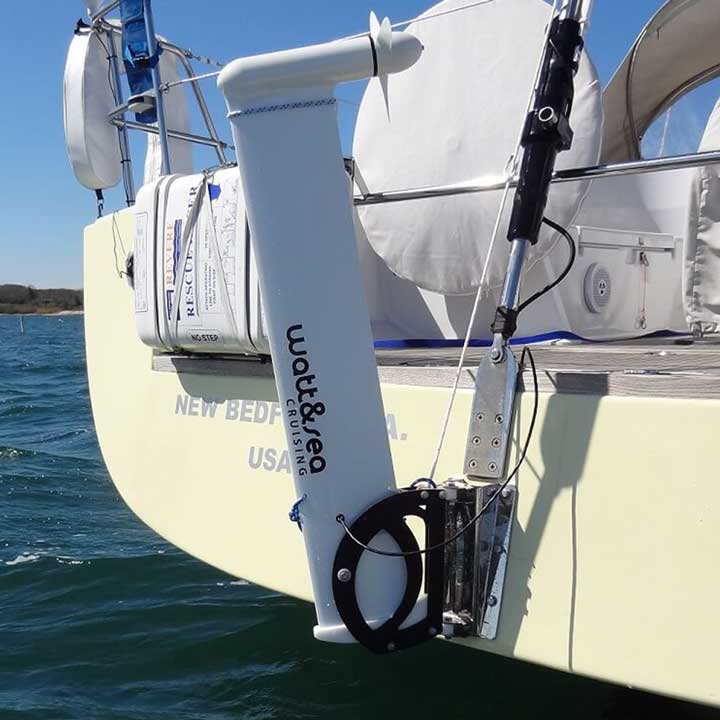
LE guide d'achat des hydrogÉnÉrateurs
Sur un bateau, le grand nombre d’instruments électroniques, qu’ils soient de confort ou de sécurité, nécessite une alimentation en électricité : la VHF, le pilote automatique, le radar, l’échosondeur, ou encore le réfrigérateur, et même la pompe de cale, sont tous connectés à une batterie. Or, celle-ci a une capacité limitée qui ne couvre pas forcément les besoins d’un navire lors d’une longue croisière ou d’une traversée de plusieurs jours. C’est pourquoi il est nécessaire, pour compenser la consommation ou recharger les batteries, de produire sa propre électricité afin d’être autonome, sans utiliser le moteur thermique.
Plusieurs solutions s’offrent à nous : les panneaux photovoltaïques, l’éolienne ou l’hydrogénérateur. Comme son nom l’indique, hydro générateur composé de hydro signifiant eau , et de générateur : qui transforme une énergie en énergie électrique. Ce dernier reprend le principe de l’éolienne, mais cette fois sous la surface de l’eau.
Ici, c’est donc la rotation de l’hélice sous l’eau qui alimente un alternateur. Plus le bateau se déplace vite, et plus la production de ressource électrique est efficace. Cette technologie, encore jeune, se présente déjà comme l’une des plus fiable, performante et vertueuse dans le milieu maritime.
Notez qu’il est tout à fait possible de multiplier les sources électriques sur un bateau. Il sera, par exemple, tout à fait à propos d’utiliser des panneaux solaires lors du mouillage, puis de préférer l’hydrogénérateur dès lors que le bateau navigue.
Qu’est-ce qu’un hydrogénérateur ?
Historique et applications
Mis au point par une légende de la course au large, l’hydrogénérateur est une révolution relativement récente dans l’univers de la voile. C’est dans un souci de performance et de respect de l’environnement que le skipper Yannick Bestaven, vainqueur du Vendée Globe, a imaginé une alternative durable et fiable à l’utilisation des énergies fossiles, en utilisant l’énergie développée par le déplacement du bateau dans l’eau. Associés à l’ingénieur Matthieu Michou, ils fondent la société Watt&Sea et créent un nouveau standard en termes de génération d’électricité en mer.
Le principe paraît évident, mais la mise en pratique n’a pas été aussi simple. Il faut que cette « sorte de turbine hydro-électrique » puisse être efficace sans pour autant nuire à la performance et à la vitesse du bateau. Il fallait donc que l’hydrogénérateur, son mâtereau et son hélice, n’engendrant pas une trainée trop importante qui risquerait de ralentir le voilier. De la même manière, il ne doit pas alourdir l’embarcation ni nécessiter des manipulations fastidieuses. C’est au cours de ses régates et grâce aux retours d’expériences de ses utilisateurs, que le skipper et ses équipes de cherche et développement ont atteint un niveau de performance leur permettant d’équiper aujourd’hui la plupart des voiliers de course au large : pour exemple, 95% des bateaux du dernier Vendée Globe étaient équipés d’un hydrogénérateur Watt&Sea.
Conçue pour la compétition et l’endurance, cette technologie n’en est pas moins accessible aux usages plus récréatifs. Les voiliers de plaisance peuvent bénéficier facilement des avantages de la production hydraulique d’électricité, leur assurant l’autonomie nécessaire lors des traversées et croisières. Il sera possible de choisir la taille de l’hélice au regard de votre vitesse moyenne de navigation.
Plusieurs types de montages sont présents sur le marché, avec chacun leurs caractéristiques propres, permettant d’adapter l’hydrogénérateur sur tous les voiliers : monocoque ou catamaran
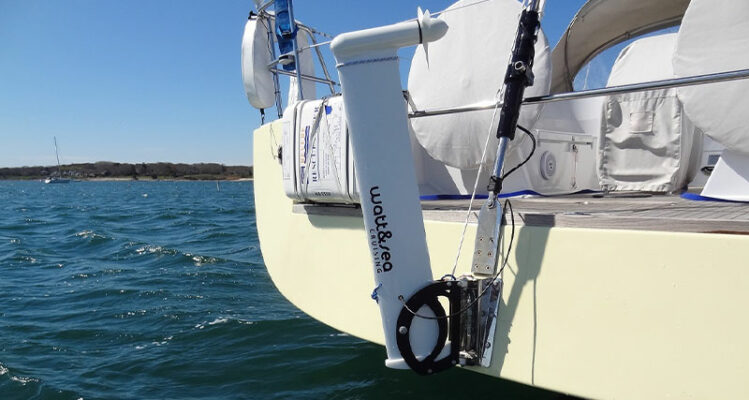
Comment fonctionne un hydrogénérateur ?
Des pales sur un axe fixe, pivotant sous l’effet du mouvement de l’eau, créant ainsi une source d’énergie … un principe vieux comme le moulin à eau. Certes, mais dans le cas de l’hydrogénérateur, ce n’est plus exactement l’eau qui se meut dans une hélice, mais bien l’hélice qui se déplace dans l’eau.
Le principe de fonctionnement est finalement assez simple, mais encore fallait-il y penser. En effet c’est le mouvement du bateau qui va créer le frottement qui entrainera l’hélice du générateur. Ce qui implique que celle-ci doit être constamment immergée afin d’offrir un rendement stable et efficace.
Comme nous pouvons le voir sur cette illustration, l’hélice est en prise directe avec l’alternateur brushless, lui-même connecté électriquement au régulateur/convertisseur 12/24V. C’est lui qui alimentera les batteries en électricité.
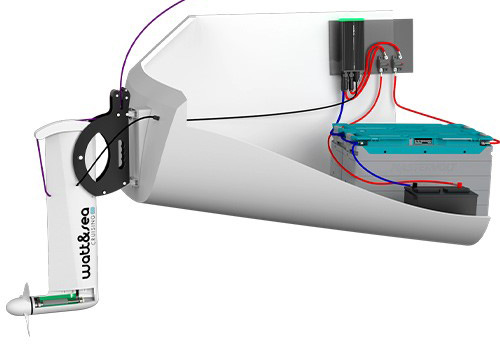
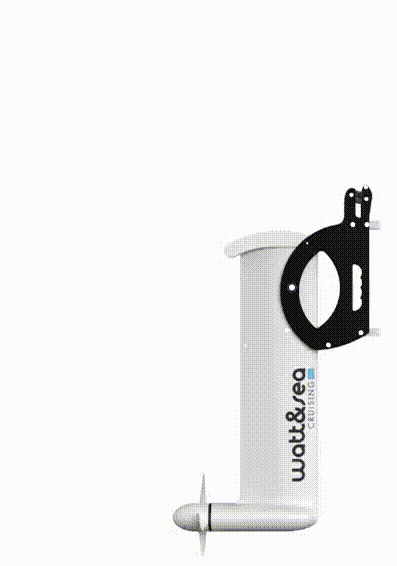
Sur le modèle représenté ici (Cruising), la fixation sur panneau arrière permet au système d’être amovible : il peut être immergé et relevé aisément à la manière d’un safran.
Une fois dans l’eau un taquet maintient l’appareil en position. Dès lors que les batteries sont chargées, il peut être relevé aussi facilement.
Le Pod 600, fonctionne sur le même principe, mais n’est pas amovible. Il s’installe sous la coque, juste derrière la quille. Quand il n’est pas possible, de par l’architecture du bateau par exemple, de l’installer sur la jupe arrière, il représente une parfaite alternative.
Il offre d’autres avantages : nécessitant moins de manipulation, étant plus discret, tout en produisant la même quantité d’électricité que son homologue à fixation sur panneau arrière.
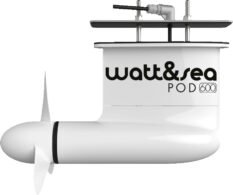
Les performances
Efficacité et production d'énergie
Je vous entends déjà : « oui, mais moi j’ai déjà des panneaux solaires sur mon voilier, je ne peux pas installer d’hydrogénérateur en plus ! » Hé bien si, vous répondrai-je. Car les sources d’énergie ne sont pas concurrentes, mais bel et bien complémentaires.
L’hydrogénérateur montre une grande efficience, mais sa production d’électricité dépendra, non seulement de la puissance du générateur, mais aussi de la taille de son hélice, ainsi que, bien sûr, la vitesse de déplacement dans l’eau. Afin de s’adapter au mieux à la consommation de votre équipement embarqué, il faudra mixer au mieux les différents éléments pour tirer le meilleur du système : une puissance adaptée à la taille de votre bateau, une longueur de mâtereau optimisant l’immersion de l’hélice et un diamètre d’hélice en accord avec la vitesse de croisière habituelle du navire.
Pour illustrer ces propos, nous avons compilé quelques données du fabricant sur deux modèles phares de la gamme Watt&Sea : le Cruising 300 et le Cruising 600. Vous constaterez les différences de rendement selon la puissance générée et la taille de l’hélice (240 ou 280 mm).
Caractéristiques techniques : Cruising 300 vs Cruising 600
|
Cruising 300 |
Cruising 600 |
|
|---|---|---|
| Taille du bateau |
<35 pieds |
>35 Pieds |
| Puissances nominale |
300 W |
600 W |
| Tension |
12 / 24 V |
12 / 24 V |
| Hélice par défaut |
240 mm |
240 mm |
|
Production à 5 nœuds avec hélice 240mm |
85 W : 7,1 A |
83,5 W : 7,1 A |
|
Production à 5 nœuds avec hélice 280mm |
111 W : 9,3 A |
122 W : 10,2 A |
|
Production à 10 nœuds avec hélice 240mm |
291 W : 24,3 A |
535,8 W : 44,6 A |
|
Production à 10 nœuds avec hélice 280mm |
297,3 W : 24,8 A |
580,6 W : 48,4 A |
Pour produire plus d’électricité à basse vitesse, il faudra préférer un plus grand diamètre d’hélice.
Une plus petite hélice produira, certes moins d’énergie à basse vitesse, mais surtout moins de trainées à vitesse plus élevée.
Pour résumé : plus vous naviguez vite, plus l’hélice doit être petite pour produit plus, plus vous naviguez doucement, plus l’hélice doit être grande. Le modèle d’hélice intermédiaire est le plus universel, il assure un bon rendement d’énergie sur la majorité des bateaux avec une faible trainée.
Comparatif rendement : Cruising 300 vs Cruising 600
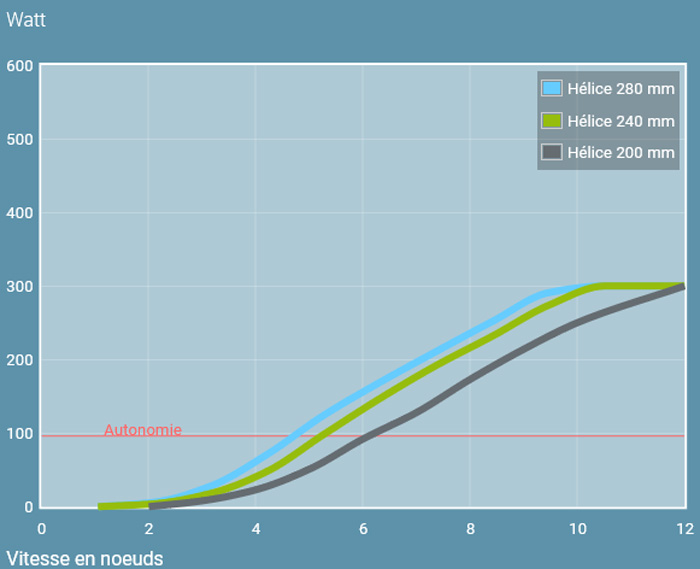
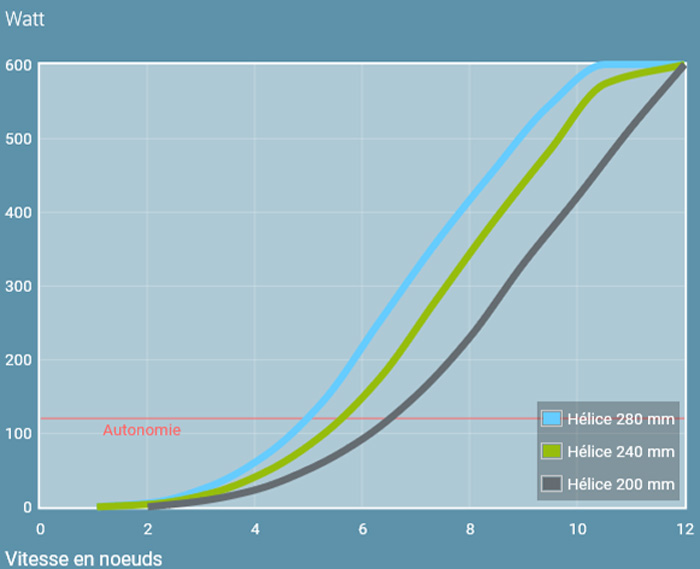
Top vente Hydrogénérateurs
Hydrogénérateur Cruising 300
Les hydrogénérateurs CRUISING 300W sont adaptés pour les plaisanciers, régatiers et les navigateurs hauturiers. Cette génération d’hydrogénérateurs sont + légers, + maniables, + hydrodynamiques et résistent à la corrosion.
Hydrogénérateur Cruising 600
Les hydrogénérateurs CRUISING 600W sont adaptés pour les plaisanciers, régatiers et les navigateurs hauturiers. Cette génération d’hydrogénérateurs sont + légers, + maniables, + hydrodynamiques et résistent à la corrosion.
Hydrogénérateur
L’hydrogénérateur POD 600 est la solution innovante pour les voiliers qui ne peuvent pas installer un hydrogénérateur sur leur jupe pour des raisons techniques, mécaniques ou esthétiques. Il s’installe sous la coque et produit les mêmes performances que les modèles historiques de la marque.
Dans quel cas choisir un hydrogénérateur ?
Comme nous l’avons précisé plus haut, l’hydrogénérateur, bien que produisant suffisamment d’électricité pour combler la consommation du bateau et recharger les batteries, ne pourra se suffire à lui-même en cas de mouillages répétés ou prolongés. C’est alors qu’il faudra le coupler avec un système solaire ou éolien. Mais y a-t-il des contre-indications à l’installation d’une hydrogénérateur ?
Si l’installation d’un hydrogénérateur est assez simple, il n’est pas toujours possible de la fixer sur le tableau arrière. De plus, l’emplacement doit également tenir compte du roulis et du déjaugeage de la coque, afin que l’immersion soit efficace. En effet, l’inclinaison de la coque peut amener l’hélice à sortir de l’eau, et de ne plus tourner.
C’est pour pallier, entre autres, à ces problématiques, que Watt&Sea propose un modèle monté sur un mâtereau plus court, venant de fixe, de manière durable, sous la coque, à l’arrière de la quille. Il s’adaptera donc à tous les types de voiliers et catamarans, tout en offrant les mêmes performances que les modèles similaires en fixation sur tableau arrière.
LA GAMME WATT&SEA
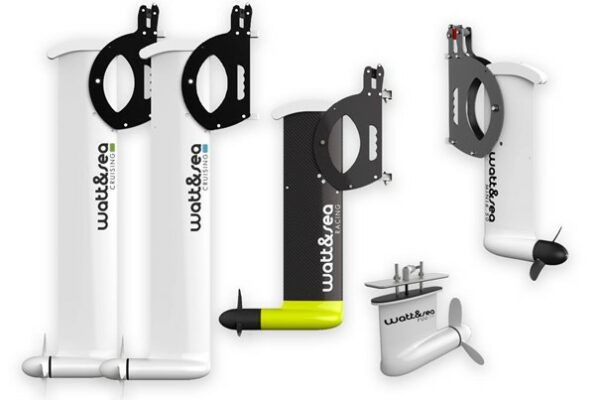
hydrogénérateurs Cruising 300 et 600
Les deux produits phares de la marque combleront la plupart
des besoins des navigateurs dans le cas de croisière ou longue traversée.
Disponibles avec 2 longueurs de mâtereau et 3 tailles d’hélice, ils sont conçus pour des bateaux de respectivement moins de 35 pieds (+/- 10m) et plus de 35 pieds.
Développant 300 ou 600 watts, ils permettent de générer suffisamment
d’électricité pour naviguer en énergie positive et à recharger les batteries si
nécessaire.
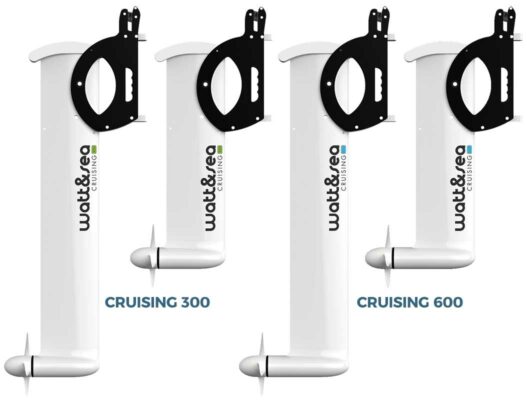
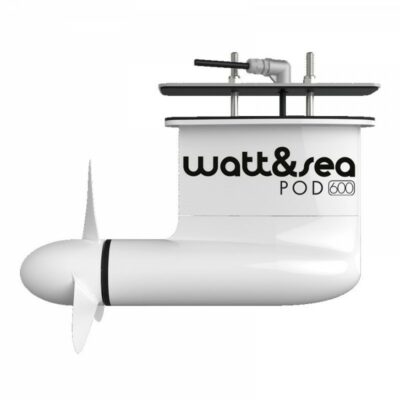
Hydrogénérateur Pod 600
Le Pod 600 est le modèle d’hydrogénérateur conçu pour les bateaux ne pouvant pas recevoir les modèles à fixation sur la jupe.
Il procure les mêmes performances que les Cruising en termes de production électrique, mais offre un gain de place, un gain esthétique et une facilité d’utilisation incroyable.
Un simple interrupteur suffit à le piloter.
Hydrogénérateur mini 6.50
Modèle très spécifique, taillé pour la course au large et la transat, le Mini 6.50 est un hydrogénérateur pour la non moins spécifique Classe Mini.
Il apporte la fiabilité et l’efficacité dont les skippers ont besoin. il est équipé d’hélices manuelle bi-pales à pas ajustable afin de répondre aux variations de vitesse
Disponible en 3 tailles de mâtereau et 2 types de fixations.
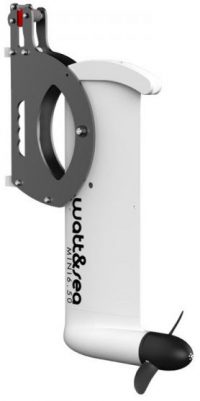
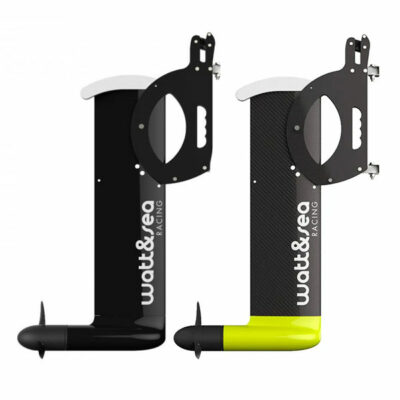
Hydrogénérateur racing
Les deux modèles de la gamme Racing, en alu ou carbone, sont optimisés pour une navigation rapide, allant de 5 à 30 nœuds. Extrêmement légers et particulièrement hydrodynamiques, ils ne génèrent qu’une trainée minimale.
Ce sont les modèles privilégiés des plus grands skippers du globe.
Les Hydrogénérateurs chez Comptoir Nautique
le spécialiste de l'électronique marine
Le spécialiste de l’électronique marine ne se contente pas de vous proposer à la vente les meilleurs produits aux meilleurs prix, il vous accompagne avec son expertise et sa grande expérience.
Nous avons choisi pour vous les hydrogénérateurs Watt&Sea pour leur immense fiabilité, leur performance et leur innovation.
Nos conseillers sont à votre écoute pour toutes vos questions techniques, vos interrogations sur la compatibilité des équipements, ou encore sur le stock disponible, ou le délai de livraison.
N’hésitez pas à nous contacter par e-mail ou par téléphone.

